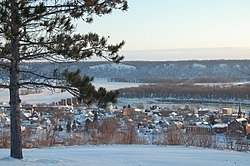Guttenberg, Iowa
| City of Guttenberg | |
|---|---|
| City | |

A view of Guttenberg from Acre Street December 2007
|
|
| Motto: The Natural Place to Do Business, Live, Work and Play! | |
 Location of Guttenberg in Iowa |
|
| Coordinates: 42°47′10″N 91°6′5″W / 42.78611°N 91.10139°WCoordinates: 42°47′10″N 91°6′5″W / 42.78611°N 91.10139°W | |
| Country | United States |
| State |
|
| County | Clayton |
| Incorporated | 1851 |
| Government | |
| • Mayor | Russell Loven |
| • City Manager | Mary Willett |
| Area | |
| • Total | 2.12 sq mi (5.49 km2) |
| • Land | 2.09 sq mi (5.41 km2) |
| • Water | 0.03 sq mi (0.08 km2) |
| Elevation | 625 ft (188 m) |
| Population (2010) | |
| • Total | 1,919 |
| • Estimate (2012) | 1,873 |
| • Density | 918.2/sq mi (354.5/km2) |
| Time zone | Central Standard Time (UTC-6) |
| • Summer (DST) | Central Daylight Time (UTC-5) |
| Zip Code | 52052 |
| Area code(s) | 563 |
| FIPS code | 19-33465 |
| GNIS feature ID | 0457187 |
| Website | City of Guttenberg |
Guttenberg is a city in Clayton County, Iowa, United States, along the Mississippi River. The population was 1,919 at the 2010 census, down from 1,987 at the 2000 census.
Prairie La Porte, meaning "the door to the prairie," was the first name given to Guttenberg by French explorers in 1673. The Guttenberg area was a site of Sac and Fox campgrounds until 1823. The Louisiana Purchase of 1803 transferred ownership to the United States and the Black Hawk Purchase of 1833 finally opened the area for legal settlement.
Guttenberg’s past is preserved today in the many limestone buildings built by German immigrants in the mid-to-late 19th century. These structures were used for both residential and commercial purposes. Many are pre-Civil War era and are on the National Historic Register (NHR).
Guttenberg's riverfront location was pivotal in its early commercial development. The town first served as a focal point for westward settlement and as an early governmental and administrative center. It was the early location of the county seat from 1838-1843. Guttenberg served as a supply center for the general area until the Civil War, when railroads and an interior road system combined to detract from Guttenberg's role as a market center.
The earliest businesses included general supply stores, blacksmith, wagon shops, and hotels. The loss of the county seat in 1843 slowed growth and the population declined. Economic revival began in 1845 with the influx of hundreds of German immigrants under the auspices of the Western Settlement Society of Cincinnati and continued with the development of the lead mining industry along Miners Creek.
The German immigration began in 1845, and by 1850 the town was sizable and nearly all German. The city takes its name from Johannes Gutenberg, the inventor of movable type. A replica of a Bible he printed is on display at the public library.
...
Wikipedia
